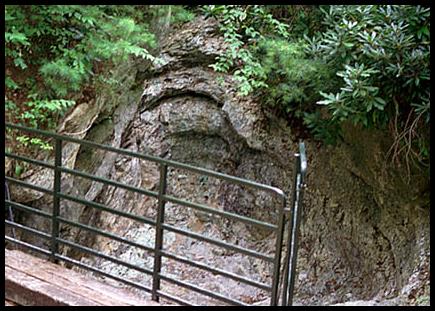Home | About Me | Jewelry Designs | Gemstones | Mineral Specimens | Mine Info | Orders | FAQs | Contact | Links |
||
 |
||||
Fluorite (var. chlorophane): McHone Pegmatite, Spruce Pine, North Carolina |
||||
The McHone pegmatite is located near Spruce Pine, North Carolina. Above is a view of the exposed pegmatite vein. The exposed section measures approximately 50 feet long, 20 feet in width, and 20 feet deep. The country rock is a mica schist. |
||||
Fluorite is calcium fluoride, CaF, a mineral mined and primarily used for flux in the making of steel. It is a soft mineral (Mohs' hardness of 4) that can be colorless, red, pink, orange, yellow, green, blue, purple, or nearly black. In the United States, major commercial depostits have been mined in the region of the Illinois-Kentucky border. Smaller deposits are widely scattered around the USA. Pegmatites are intrusive bodies of coarsely crystalline granite-like rock composed mainly of feldspar, quartz and mica. Occasionally, pegmatites contain fine gemmy crystals of tourmaline, topaz and other minerals. A few unusual pegmatites contain chlorophane, a rare variety of fluorite. Chlorophane is remarkable in that it displays fluorescence, phosphorescence, and thermoluminescence. Some chlorophane will fluoresce blue or green when illuminated with long wave or short wave UV light. When illuminated with a bright visible light source, and then viewed in darkness, chlorophane displays a lingering green to blue glow. This phosphorescent glow can last for many minutes. The most intriguing and distinguishing property of chlorophane fluorite is its thermoluminescence. When heated by flame or electric coil, chlorophane emits a The classic U.S. locality for cholorphane has been a pegmatite at Amelia Court House, Virginia. Recently, Mitchell and Loretta Warlick of Spruce Pine, North Carolina, have begun mining a small pegmatite located on their property (see above image). The Spruce Pine area is famous for huge pegmatite-like deposits (alaskite) that produce massive amounts of feldspar and quartz, each used repectively in the ceramics and semiconductor industry. Near the huge open pit alaskite mines are much smaller complex pegmatites ( |
||


